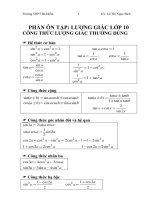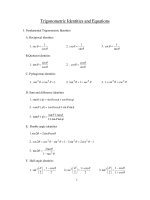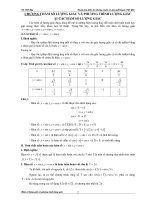công thức và phương trình lượng giác tiếng anh
Bạn đang xem bản rút gọn của tài liệu. Xem và tải ngay bản đầy đủ của tài liệu tại đây (98.51 KB, 9 trang )
Trigonometric Identities and Equations
I. Fundamental Trigonometric Identities
A. Reciprocal identities
1.
θ
θ
cos
1
sec =
2.
θ
θ
sin
1
csc =
3.
θ
θ
tan
1
cot =
B.Quotient identities
1.
θ
θ
θ
cos
sin
tan =
2. .
θ
θ
θ
sin
cos
cot =
C. Pythagorean identities
1.
2. 3. 1cossin
22
=+
θθ θθ
22
sec1tan =+
θθ
22
csccot1 =+
D. Sum and difference identities
1.
φ
θ
φ
θ
φ
θ
sincoscossin)sin( ±
=
±
2.
φ
θ
φ
θ
φ
θ
sinsincoscos)cos( m=±
3.
φθ
φ
θ
φθ
tantan1
tantan
)tan(
m
±
=±
E. Double angle identities
1.
θ
θ
θ
cossin22sin =
2.
1cos2sin21sincos2cos
2222
−=−=−=
θθθθθ
3.
θ
θ
θ
2
tan1
tan2
2tan
−
=
F. Half angle identities
1.
2
cos1
2
sin
2
θθ
−
=
⎟
⎠
⎞
⎜
⎝
⎛
2.
2
cos1
2
cos
2
θθ
+
=
⎟
⎠
⎞
⎜
⎝
⎛
3.
θ
θθ
cos1
cos1
2
tan
2
+
−
=
⎟
⎠
⎞
⎜
⎝
⎛
1
G. Miscellaneous identities
1.
θ
θ
sin)sin( −=−
2.
θ
θ
cos)cos( =−
3.
θ
θ
tan)tan( −=−
4.
⎟
⎠
⎞
⎜
⎝
⎛
⎟
⎠
⎞
⎜
⎝
⎛
±
=±
2
cos
2
sin2sinsin
ϕθϕθ
ϕθ
m
5.
⎟
⎠
⎞
⎜
⎝
⎛
−
⎟
⎠
⎞
⎜
⎝
⎛
+
=+
2
cos
2
cos2coscos
ϕθϕθ
ϕθ
6.
⎟
⎠
⎞
⎜
⎝
⎛
−
⎟
⎠
⎞
⎜
⎝
⎛
+
−=−
2
sin
2
sin2coscos
ϕθϕθ
ϕθ
7.
)sin(
2
1
)sin(
2
1
cossin
ϕθϕθϕθ
−++=
8.
)sin(
2
1
)sin(
2
1
sincos
ϕθϕθϕθ
−−+=
9.
)cos(
2
1
)cos(
2
1
coscos
ϕθϕθϕθ
−++=
10.
)cos(
2
1
)cos(
2
1
sinsin
ϕθϕθϕθ
+−−=
11.
θ
θ
θ
θθ
sin
cos1
cos1
sin
2
tan
−
=
+
=
⎟
⎠
⎞
⎜
⎝
⎛
H. Useful suggestions for proving trigonometric identities
1. Avoid aimless transformations. Any transformation that is made in one of the
members should lead in some way to the form of the other.
2. Start with the more complicated member of the identity and transform it into
the form of the simpler member.
3. Where possible, express different functions in terms of the same function.
4. It is often useful to express all functions in terms of sines and cosines, or in
terms of tangents and secants.
2
5. As a rule, trigonometric functions of a double angle, a half angle, or the sums
and differences of angles should be expressed in terms of functions of the
single angle.
6. Simplify expressions by utilizing basic identities and combining like terms.
7. Simplify fractions. For example, transform complex fractions into simple
fractions or divide the terms of a fraction by the common factors.
I. Examples
1. Using trigonometric identities and fundamental trigonometric function values,
find each of the following:
(a)
2
32
4
32
2
2
3
1
2
60cos1
2
30
sin15sin
−
=
−
=
−
=
−
=
⎟
⎟
⎠
⎞
⎜
⎜
⎝
⎛
=
oo
o
(b)
−
⎟
⎟
⎠
⎞
⎜
⎜
⎝
⎛
⎟
⎟
⎠
⎞
⎜
⎜
⎝
⎛
=−=+=
2
3
2
2
30sin45sin30cos45cos)3045cos(75cos
ooooooo
4
26
2
1
2
2 −
=
⎟
⎠
⎞
⎜
⎝
⎛
⎟
⎟
⎠
⎞
⎜
⎜
⎝
⎛
(c)
2
1
30sin)]15(2sin[15cos15sin2 ===
oooo
(d)
32
32
1
2
3
1
2
1
30cos1
30sin
2
30
tan15tan −=
+
=
+
=
+
=
⎟
⎟
⎠
⎞
⎜
⎜
⎝
⎛
=
o
oo
o
(e)
=−++= )5.75.37cos(
2
1
)5.75.37cos(
2
1
5.7cos5.37cos
oooooo
4
32
2
3
2
1
2
2
2
1
30cos
2
1
45cos
2
1 +
=
⎟
⎟
⎠
⎞
⎜
⎜
⎝
⎛
⎟
⎠
⎞
⎜
⎝
⎛
+
⎟
⎟
⎠
⎞
⎜
⎜
⎝
⎛
⎟
⎠
⎞
⎜
⎝
⎛
=+
oo
3
2. Prove:
xx
x
x
tansin
csc
sec1
+=
+
()()
+=+=+=+=
+
x
x
x
x
x
x
x
x
x
xx
x
sin
1
sin
cos
1
sin
sin
1
cos
1
sin
csc
sec
csc
1
csc
sec1
xx
x
x
tansin
cos
sin
+=
3. Prove:
x
x
x
x
x
2sin
2
cos
sin
sin
cos
=+
==
+
=+=+
xxxx
xx
xx
xx
xx
xx
x
x
x
x
cossin
1
cossin
sincos
cossin
)(sinsin
cossin
)(coscos
cos
sin
sin
cos
22
x
x
x
2sin
2
cossin2
2
=
4. Prove:
yx
yx
yx
yx
tantan
tantan
)sin(
)sin(
−
+
=
−
+
=
⎟
⎟
⎠
⎞
⎜
⎜
⎝
⎛
−
⎟
⎟
⎠
⎞
⎜
⎜
⎝
⎛
+
=
−
+
=
−
+
))(cos(cos
cos
sin
cos
sin
))(cos(cos
cos
sin
cos
sin
cos
sin
cos
sin
cos
sin
cos
sin
tantan
tantan
yx
y
y
x
x
yx
y
y
x
x
y
y
x
x
y
y
x
x
yx
yx
)sin(
)sin(
cossincossin
cossincossin
yx
yx
xyyx
xyyx
−
+
=
−
+
II. Solution of Trigonometric Equations
A. Useful suggestions for solving trigonometric equations
1. Simplify the equation by clearing fractions, removing parentheses, combining
like terms, and removing radicals.
2. Express functions of a double angle, a half angle, or the sums and differences
of angles in terms of functions of the single angle; then express the different
functions of the single angle in terms of a single function of that angle.
4
3. Solve the resulting equation, whether it be linear or quadratic in nature, for all
the values of the angle in the given domain.
4. Checks the results by substituting into the
original equation.
B. Examples
1. Solve for
x in the interval
:)2,0[
π
03sin2 =+x
2
3
sin3sin203sin2
−
=⇒−=⇒=+
xxx
. Get the reference angle
).60(
32
3
sin
1 o
π
=
⎟
⎟
⎠
⎞
⎜
⎜
⎝
⎛
−
Since is negative, x lies in the 3
xsin
rd
and 4
th
quadrants. Thus,
)240(
3
4
)60(
3
)180(
ooo
π
π
π
=+=x
or −= )360(2
o
π
x
)300(
3
5
)60(
3
oo
π
π
=
. Both of these values do check.
2. Solve for
x in the interval
:)2,0[
π
x
x
x
tancoscos
=
⇒=
−
⇒
=
−
⇒= 0)tan1(cos0tancoscostancoscos xxxxxxxx
or
0cos =x 0cos0tan1
=
⇒=− xx
or
1tan
=
x
.
2
0cos
π
=⇒= xx
( )90
o
or
).270(
2
3
o
π
=x
⇒
=
1tanx
reference angle =
)45(
4
)1(tan
1 o
π
=
−
. Since
x
tan is positive, x lies in the 1
st
and 3
rd
quadrants. Thus,
)45(
4
o
π
=x
or x =
).225(
4
5
)45(
4
)180(
ooo
π
π
π
=+
Thus, the solutions are
2
3
,
4
5
,
2
,
4
π
π
π
π
orx =
and they all check.
3. Solve for
x in the interval
:)2,0[
π
13cos2
=
x
2
1
3cos13cos2 =⇒= xx
. Since
π
20
<
≤
x
,
π
60
<
≤
x
. The reference angle
for 3
x is
)60(
32
1
cos
1 o
π
=
⎟
⎠
⎞
⎜
⎝
⎛
−
and is positive in the 1
xcos
st
and 4
th
quadrants.
Thus,
)60(
3
3
o
π
=x
,
)300(
3
5
)60(
3
)360(23
ooo
π
π
π
=−=x
, += )360(23
o
π
x
5
)420(
3
7
)60(
3
oo
π
π
=
,
)660(
3
11
)60(
3
)720(43
ooo
π
π
π
=−=x
, += )720(43
o
π
x
)780(
3
13
)60(
3
oo
π
π
=
, and
⇒=−= )1020(
3
17
)60(
3
)1080(63
ooo
π
π
π
x
9
17
,
9
13
,
9
11
,
9
7
,
9
5
,
9
π
π
π
π
π
π
orx =
and they all check.
4. Solve for
x in the interval
:)2,0[
π
xx cos2cos
=
−⇒=−−⇒=−⇒=
xxxxxxx
22
cos20cos)1cos2(0cos2coscos2cos
01cos20)1)(cos1cos2(01cos
=
+
⇒
=
−
+
⇒=− xxxx
or
⇒=− 01cosx
2
1
cos −=x
or .
1cos =x
⇒−=
2
1
cos x
reference angle is
32
1
cos
1
π
=
⎟
⎠
⎞
⎜
⎝
⎛
−
and
x lies in the 2
nd
or 3
rd
quadrants since is negative
xcos
3
2
3
π
π
π
=−=⇒ x
or
3
4
3
π
π
π
=+=x
.
01cos
=
⇒
=
xx
. Thus,
3
4
,
3
2
,0
π
π
orx =
and they all
check.
5. Solve for
x in the interval
:)2,0[
π
xx cossin
=
⇒=⇒=⇒= 1tan1
cos
sin
cossin x
x
x
xx
reference angle is
4
)1(tan
1
π
=
−
and
x lies in the 1
st
or 3
rd
quadrants since
x
tan
is positive
4
π
=⇒ x
or +=
π
x
4
5
4
π
π
=
and they both check.
6
Practice Sheet – Trigonometric Identities and Equations
I. Verify the following identities:
(1)
xx
x
x
tansin
csc
sec1
+=
+
(2)
x
x
x
2sin1
2cos
4
tan
−
=
⎟
⎠
⎞
⎜
⎝
⎛
+
π
(3)
x
x
x
sin2
sec
2csc =
(4)
x
xx
sec2
1sec
2
sin
2
−
=
⎟
⎠
⎞
⎜
⎝
⎛
(5)
x
x
x
xx
3tan
4sin2sin
2cos4cos
=
−
−
II. Solve the following equations for all values of
x in the interval [0,
π
2
)
:
(1)
(2)
3sin54sin3 −=− xx
xxx cos3cossin2 =
(3)
(4)
01cos4
2
=−x 3sin3cos2
2
=+ xx
(5)
1cossin =− xx
Solution Key for Trigonometric Identities and Equations
I. (1)
xx
x
x
x
x
x
x
x
x
xx
x
tansin
1
sin
cos
1
sin
sin
1
cos
1
sin
csc
sec
csc
1
csc
sec1
+=
⎟
⎠
⎞
⎜
⎝
⎛
⎟
⎠
⎞
⎜
⎝
⎛
+=+=+=
+
(2)
()
()
=
−
+
=
−
+
=
−
+
=
−
+
=
⎟
⎠
⎞
⎜
⎝
⎛
+
xx
xx
x
x
x
x
x
x
x
x
x
sincos
sincos
cos
sin
1
cos
sin
1
tan1
tan1
tan
4
tan1
tan
4
tan
4
tan
π
π
π
x
x
xxxx
xx
xxxx
xxxx
2sin1
2cos
sinsincos2cos
sincos
)sin)(cossin(cos
)sin)(cossin(cos
22
22
−
=
+−
−
=
−−
−+
7
(3)
x
x
x
x
x
x
x
x
x
x
sin2
sec
sec
sin2
1
cos
1
sin2
1
cossin2
1
2sin
1
2csc =⋅=⋅===
(4)
x
x
x
x
x
x
x
x
x
xx
sec2
1sec
sec2
cos
cos
cos
1
cos
2
cos
cos1
2
cos1
2
sin
2
−
=
−
=
−
=
−
=
⎟
⎠
⎞
⎜
⎝
⎛
(5)
=
−
−
=
⎟
⎠
⎞
⎜
⎝
⎛
+
⎟
⎠
⎞
⎜
⎝
⎛
−
⎟
⎠
⎞
⎜
⎝
⎛
−
⎟
⎠
⎞
⎜
⎝
⎛
+
−
=
−
−
xx
xx
xxxx
xxxx
xx
xx
3cos)sin(2
sin3sin2
2
42
cos
2
42
sin2
2
24
sin
2
24
sin2
4sin2sin
2cos4cos
x
x
x
x
x
xx
3tan
3cos
3sin
3cossin2
sin3sin2
==
−
−
II.
(1)
6
11
,
6
7
2
1
sin3sin54sin3
π
π
=⇒−=⇒−=− xxxx
and they both check.
(2)
2
3
sincos3cossin2 =⇒= xxxx
or
3
2
,
3
0cos
π
π
=⇒= xx
or
2
3
,
2
π
π
=x
and they all check.
(3)
3
5
,
3
4
,
3
2
,
32
1
cos01cos4
2
π
π
π
π
=⇒±=⇒=− xxx
and they all check.
(4)
⇒=+−⇒=+−⇒=+ 01sin3sin23sin3)sin1(23sin3cos2
222
xxxxxx
2
1
sin0)1)(sin1sin2( =⇒=−− xxx
or
6
5
,
6
1sin
π
π
=⇒= xx
or
2
π
=x
and
they all check.
(5)
()( )
+=⇒+=⇒+=⇒=− 1sincos1sincos1sin1cossin
2
22
xxxxxxx
⇒=+⇒++=−⇒+ 0cos2cos2coscos21cos1coscos2
2222
xxxxxxx
0cos0)1(coscos2
=
⇒=+ xxx
or
2
3
,
2
1cos
π
π
=⇒−= xx
or
π
=x
.
2
π
=x
or
π
=x
are the solutions because they both check. However,
2
3
π
=x
does not check in the original equation and thus is not a solution. [Note:
2
3
π
=x
is an extraneous root created by squaring both sides of the original
equation.]
8









